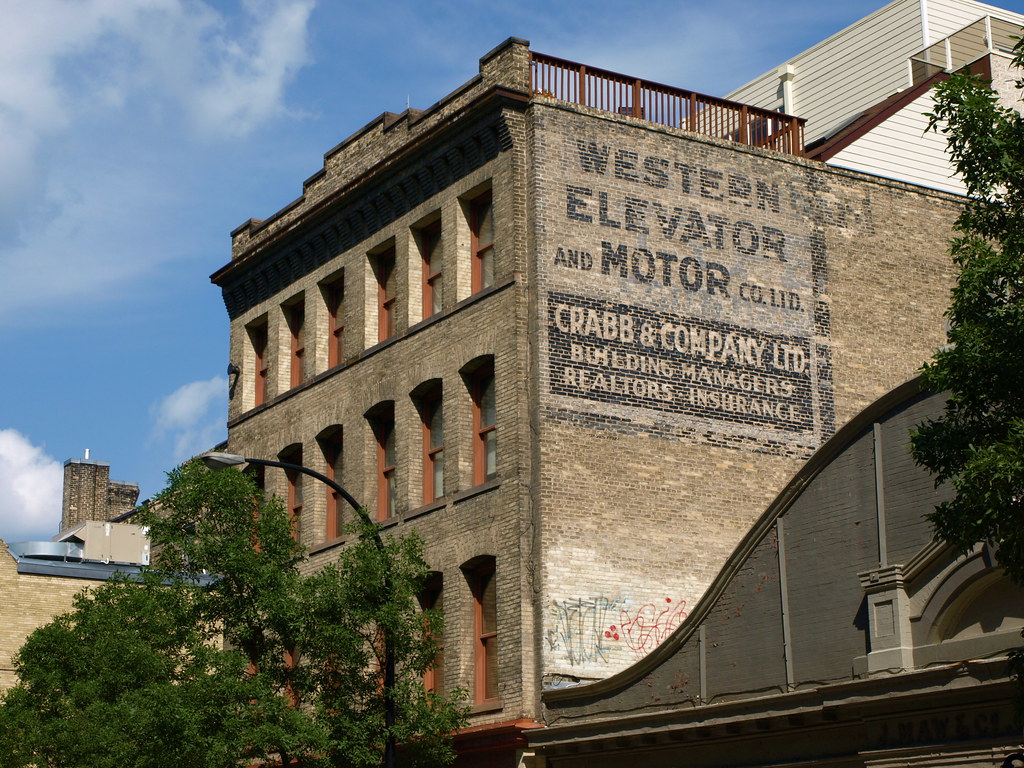I’m in Winnipeg this week attending the Fringe Festival; it’s a captivating 10-day event that hosts over 150 theatrical productions from around the world, and it centres on the wonderfully-preserved and revitalized Exchange District and Old Market Square.
I grew up here in the 60s and 70s, and in those days no one I knew ever went to the Exchange District; in fact back then the area didn’t even go by any name at all and unless you were employed by one of the mid-century businesses that still valued the low rent and central location the district – fur storage, typewriter repair, offset printers, that sort of thing – you had no reason to show your face along the grimy streets just north of the famous corner of Portage and Main. Really, the district had been in slow decline since a short period of boom in the ‘teens and twenties when the civic fathers imagined that their role in the Western Canadian grain trade would soon turn the city into “The Chicago of the North”.
Of course, nothing much got built in the dirty 30s, the 40s were all about the war, and by the 50s there was already the idea that real businesses set up along the truck routes spreading out to the suburbs and beyond; by then, the district’s business activity was already starting to wither away.
But when a new appreciation for intimate and walkable urban spaces started to surface across Canada a couple of decades ago, there were the old buildings and narrow streets of the Exchange, their deserted old lofts already beginning to be turned into low-rent artists studios and offices for cash-strapped cultural organizations. Cafes, galleries, and eclectic retail followed – and in classic Richard Florida fashion, the area now bustles with creative commerce and cultural activity.
In a happy coincidence, a few days ago during another pleasurable day in the Exchange I stopped into a coffee shop and picked up a copy of the Winnipeg Free Press someone had left behind; in the Editorial section there was a thoughtful op-ed by Robert Galston explaining how the success of the Exchange had come to pass. As a couple of hundred people crowded Albert Street just outside my window to watch the buskers and dozens wandered through the stalls of street vendors just across the lane, I read about just how this urban space had succeeded, while other far more expensive attempts at revitalization had failed:
In 1969, while planners like Earl Levin were attempting to transform Portage Avenue and the blocks south of it into a scene from The Jetsons, the Exchange sat forgotten. There was hardly a street tree or park bench to be found, and decades of grime had dirtied the facades of its great buildings.
Money was gradual. In the 1980s, when post-Modern renewal was wiping out whole city blocks of Portage Avenue under the Core Area Initiative, public money trickled into the Exchange, to comparatively modest plans: installing trees, restoring a few buildings, and beginning to reform antiquated zoning codes.
There was no master plan for the entire neighbourhood; no one dictating “this is where a boutique zone will go, night clubs over here, and up there we’ll create an education district.” Effort was micro-scaled, not micro-managed.
Most importantly, government efforts generally respected and defended the physical scale and context. The things Jane Jacobs wrote were necessary for a district’s vitality — mixed uses, density, small blocks, and old buildings — were seen as elements to uphold in the Exchange. On Portage Avenue, they were seen as obstacles to overcome.
You can read the whole piece here; Robert’s own blog featuring historic Winnipeg streetscapes is also good reading.
In a related thought, while in town for last summer’s Fringe I was struck by the number and variety of vintage painted signs still visible around the Exchange, especially on the leeward southern and eastern sides of the old brick buildings. If you look up practically anywhere you can see advertisements for long-defunct businesses; they give an extra layer of visual interest to the remarkable district. Click on the image above to see a short slideshow of some of the overhead views to be seen in the area.



4 comments
Enjoy Winnipeg! I’ve been in Toronto for three years now, and the Exchange District during the summer is one of the things I miss the most about my hometown. The Fringe Festival is probably my favourite ten consecutive days of the year in Winnipeg.
(Also, while you’re there, see if you can drum up some support for the creation of a Spacing Winnipeg, or Spacing Prairies. There’s a too-wide gap between Spacing Ottawa/Toronto and the forthcoming Spacing Vancouver!)
good post and my sentiments exactly, Evan.
I love the photos – now that’s my Winnipeg.
good thing I’m going back for a weekend soon – otherwise it would make me homesick.
but what are your thoughts on waterfront drive?
Kevin
Alas with progress come high prices.
I wished the yuppie lifestyle would have
stayed in the 80s. The creative madness
and blue collar ethos in North America
have evaporated over the decades.